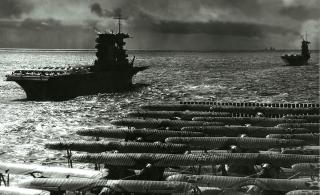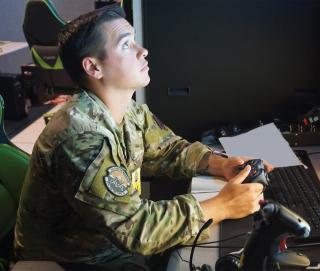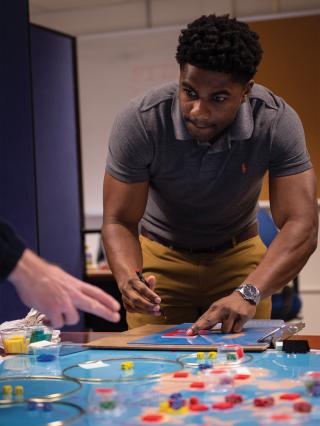Captain Patrick Molenda
2025: The South China Sea

With a sense of urgency spurred by increasing friction with China over a series of territorial disputes, the U.S. Navy was ready when Chinese leaders decided to take on the U.S. Pacific Fleet. The conflict began when a China Coast Guard vessel aggressively challenged a lone U.S. destroyer conducting freedom-of-navigation operations around Second Thomas Shoal in the South China Sea.
After a series of close crossings, the two ships collided when the Chinese captain tried to shoulder the U.S. destroyer toward a frothing reef. The destroyer’s commanding officer skillfully maneuvered to avoid grounding while the harassing vessel desperately fought to contain catastrophic flooding. Damaged, but still mission capable, the U.S. warship alerted her chain of command while establishing a defensive posture. Chinese high command, insisting the United States infringed on its sovereign territory and caused the collision, escalated the situation by seizing a U.S. survey ship operating in the South China Sea. Major elements of China’s South Sea Fleet put to sea as the Chinese president proclaimed, “Any foreign ship operating without permission in our territorial seas will be sent to the bottom.”
The USS Ranger (CV-4), Saratoga (CV-3), and Lexington (CV-2) steam forward with packed flight decks during Fleet Problem XIX in spring 1938. Fleet Problems included robust experimentation with new concepts and technology and helped develop the doctrine the Navy used to prevail at sea during World War II. U.S. Naval Institute Photo Archive
As People’s Liberation Army Navy (PLAN) forces surged east, the U.S. Pacific Fleet—led by elements of Third and Seventh Fleets and reinforced by 3d Marine Expeditionary Force—sprang into action. U.S. surface action groups and aircraft carriers positioned for combat, their movements masked by a coordinated disruption of Chinese communication and surveillance systems. U.S. Marine Corps mobile missile batteries closed off key choke points while attack submarines formed wolf packs and maneuvered into killing positions.
Having suddenly lost the ability to track U.S. combatants and communicate with their own, Chinese leaders were paralyzed by confusion. Seizing the initiative, U.S. forces leveraged their distributed network of sensors and weapons and unleashed a deadly barrage from under, on, and above the sea, decimating the Chinese fleet in minutes. While a successful operation by most accounts, the Pacific Fleet commander felt he had incurred too many losses. He called for his team to meet him in the war room to replay the scenario, readjust tactics, and run the simulation again.
Preparing for Great Power Conflict
As the Navy strives to accelerate warfighting advantages, rigorous analysis—driven by modeling and simulation, wargames, and experimentation—plays a critical role in implementing new tactics, concepts, and capabilities. The Navy has been using live, virtual, constructive (LVC) learning technologies—which link live platforms with simulations in virtual environments—to train at the tactical level of war for more than a decade, but it has struggled to scale these capabilities up to the operational and strategic levels of warfare.
Injecting LVC technologies into Fleet Battle Problems and joint exercises could revolutionize how the Navy trains, exercises, and rehearses for naval and joint warfare and better prepare the service to prevail in a future war with China.
Fleet Problems: The Interwar Years
In the decade before World War II, the Navy found itself in a unique position of not being overly burdened with overseas presence requirements or called on to engage in distant combat operations. Taking advantage of this opportunity, it focused inward and concentrated on refining fleet operations and tactics through large-scale fleet exercises called Fleet Problems.
Between 1922 and 1941, the Navy conducted 21 Fleet Problems—usually annually—spanning the globe. Fleet Problems were orchestrated over the course of several months. They were largely unscripted, included robust experimentation with innovative concepts and new technology, and involved most of the Navy’s resources. Participating forces were commanded by the same leaders who would command them in wartime.
Fleet Problems’ primary objectives included:
• Training the fleet in large-scale maneuvers
• Training and testing commanders and their staffs to plan and conduct fleet-level combat operations
• Rehearsing war plans, concepts of operations, and fleet tactics
• Experimenting with new technology
The Fleet Problems of the interwar years were highly successful and spurred the development of doctrine, tactics, and technology that ultimately played a key role in defeating Japan.
Fleet Problems Redux

An Air Force airman using a hand-held video game controller during a joint training exercise. The Distributed Mission Operations center uses its live, virtual, and constructive capabilities to connect simulators and live aircraft in a dynamic battlespace, incorporating multiple Air Force, Space Force, Navy, Marine Corps, and Army platforms. U.S. Air Force (Deb Henley)
In 2016, the U.S. Pacific Fleet resurrected the Fleet Problem concept, rebranded as Fleet Battle Problems. Though a far cry from the Navy’s comprehensive approach to fleet training during the interwar period, today’s Fleet Battle Problems arguably are the most effective venue for conducting live, high-end warfighting training and rehearsals. Unfortunately, because of global demands, advancements in modern warfare, and training infrastructure limitations, Fleet Battle Problems are not enough to keep pace with the Navy’s training requirements.
Fleet Battle Problems are carried out by naval forces that are fully trained and certified for a wide array of tactical-level operations, and they mostly involve aircraft carrier strike groups and expeditionary strike groups transiting to or returning from deployment. The exercises are designed as graduate-level high-end warfighting rehearsals in which participating forces learn and refine operational concepts through unscripted free play against a determined red force. Each Fleet Battle Problem is based on a selection of warfighting hypotheses derived from wargames and other analyses. Fleet Battle Problems also incorporate asymmetric capabilities mature enough to be evaluated in a real-world setting. The outcomes are assessed in detail, with results and recommendations reviewed by fleet commanders and other senior leaders.
Though revived Fleet Battle Problems have value, they fall short of mirroring the complex and comprehensive naval maneuvers conducted during the interwar years. The demands on the Navy today, especially in conducting “competition” focused operations, are high. The fleet simply does not have the time or resources to train at the scale and intensity it did before World War II.
Fleet Battle Problems also are inhibited by the complexity of all-domain warfare, which the Navy is striving to master. Advancements in space, cyber, long-range fires, electromagnetic maneuver, and unmanned systems make it increasingly difficult to bring to bear all the components needed to train for a naval campaign—especially with an antiquated training environment.
Conducting advanced fleet-level training that examines emerging capabilities and new operational concepts will remain challenging for the Navy if it clings to traditional methods. The Navy must incorporate new technology and ideas into training beyond the tactical level and institute a fully informed environment for exercising, rehearsing, and developing thinking warfighters.
Adding LVC
To maximize naval exercises and Fleet Battle Problems, the Navy must accelerate its focus and investment in LVC training capabilities at the task force level and above. Though the Navy is focusing attention on injecting LVC to augment training at the tactical and unit levels, there has been little attention to incorporating LVC tools such as large-scale data mining, artificial intelligence, and machine learning in operational-level-of-war education and training, where it is needed most. This is especially problematic as warfare technologies rapidly advance and outgrow the training ranges built for Cold War–era training requirements.
In a recent interview, Admiral Daryl Caudle, head of the Navy’s Fleet Forces Command, stated when referring to LVC’s role in training, “The service already has mature, connected training systems on ships and training ranges to make the training systems more realistic and inclusive of new weapons.”1 To that point, Caudle said the Navy would make further investments in LVC systems over the next 15 years. He went on to point out that the Navy would use its Ready Relevant Learning training model enhanced with LVC to ensure individual sailors, small units, and ship crews are prepared to jump into action quickly if called on outside their typical deployment cycle.
While this is an important initiative and likely will improve the Navy’s unit- and strike-group–level training, it is not bold enough to bring the entire naval and joint team together to train to win against a peer adversary. The size and scope of today’s fleet training areas cannot support modern warfare requirements for long-range all-domain fires or distributed maritime operations, let alone for fully integrated joint and combined forces. Advanced LVC must be pursued so the Navy can be prepared to conduct complex naval operations at the operational level of war and prevail against a capable and determined adversary.2
Progress is being made in use of LVC technologies, but the pace is slow. The Indo-Pacific Multi-Domain Training and Experimentation Capability (PMTEC) is an ambitious effort to connect multiple ranges across the Pacific and infuse LVC capabilities.3 The PMTEC initiative is perhaps the most promising step forward, as it is well-resourced and led by a dedicated and innovative team of contractors, government civilians, and active-duty military. However, despite progress and investment in such initiatives, there is not enough focus on expanding virtual tools beyond the tactical training environment to deliver realistic warfighting scenarios at the operational or strategic levels of war.
For example, expanding LVC beyond the tactical level would allow maritime operations centers to carry out schemes of maneuver involving multiple carrier and expeditionary strike groups, along with joint and coalition capabilities against a complex adversary—in both live and virtual scenarios. The force would be networked, orchestrated, and supported by a fused LVC constellation incorporating capabilities from all warfare domains. Ideally, such an environment would stress not only tactical commanders, but also three- and four-star commanders and their staffs so they could rehearse their warfighting roles, much like leaders did during the interwar years.
A Wargaming Renaissance
Another catalyst for warfighting innovation during the interwar years was wargaming. Throughout the 1930s, there was symbiosis in the wargames conducted at the Naval War College in Newport, Fleet Problems, and the Navy’s General Board. Through intense, iterative wargaming, the Naval War College helped shape War Plan Orange, which is credited as the blueprint for the success of naval campaigns against the Japanese in Pacific.4

Students and instructors practice complex war strategies at the Naval War College. Although the Naval War College’s wargaming capabilities in some ways remain the gold standard, its methodology and approach have not substantially evolved to include new technologies, such as cloud-based computing capabilities, machine learning, and big data. U.S. Navy (Brett Dodge)
The Naval War College’s wargaming capabilities in some ways remain the gold standard; however, its methodology and approach have not substantially evolved over the past decades.5 It has not taken advantage of the explosion of cloud-based computing capabilities, machine learning, and big-data exploitation to transform wargaming into the educational weapon needed to defeat future adversaries.
While wargames have several applications, their primary purpose is to examine warfighting plans and concepts against a thinking red team to reveal flaws in planning, schemes of maneuver, and integration of novel capabilities. Wargames alone do not validate any capability or concept, but, when properly crafted, they can provide valuable insights for war planning, decision-making, and force employment.
The problem is that Naval War College wargames remain manpower intensive. They rely heavily on subjective adjudication dependent on Monte Carlo probability tables and fleet operators (most often a pick-up team) providing biased force-on-force engagement opinions. Postgame analysis is largely driven by participant surveys, which rarely lead to actionable, data-supported outcomes. The Navy’s premier wargaming institution is still rolling dice when it should be playing Moneyball.6
The Navy can do better by infusing powerful computing technology—such as the applications that drive commercial gaming platforms—to enhance wargame design, execution, adjudication, and postgame analysis. The power in these commercial platforms is not their theater-quality graphics; it is their ability to harvest and make sense of massive amounts of data, which can be used to replicate complex and dynamic combat conditions at warp speed and provide outcomes digitally. Using those predicted outcomes, commanders can then develop alternative courses of actions based on changing variables. When combined with machine learning, the synthesis of simulation and wargaming can enhance advanced warfighting education and decision-making.
What Next?
In the early days of World War II, the Navy learned to exploit warfighting concepts and technological breakthroughs in radar, torpedo tactics, and naval gunfire to significantly increase its lethality against Japan. Today’s Navy can similarly leap ahead by embracing high-speed processing, mega-data mining, and machine learning to shape a learning environment that links all levels of warfare.
In his book, Learning War, Trent Hone says the U.S. Navy historically has been a premier complex adaptive system—meaning a lens that clarifies the dynamic nature of mechanisms that foster and sustain innovation. Hone theorizes that during World War II, these mechanisms allowed the service to rapidly explore new technologies and concepts to exploit wartime opportunities.7 It is debatable whether the Navy remains such an adaptive system. However, the Navy risks losing more ground to pacing threats if it does not embark on a cultural and technological shift to align doctrine, tactics, capabilities, and concepts with focused preparation for peer naval warfare. This will not be achieved using current training and education methods.
To accelerate the comprehensive virtual training environment, virtual warfare centers should be established on both coasts—the Naval War College in Newport, Rhode Island, and the Naval Postgraduate School in Monterey, California, being prime candidates. Similar capabilities should be established in Hawaii, Norfolk, San Diego, and perhaps Japan. The Navy also should leverage the Marine Corps Warfighting Laboratory’s new wargaming facility, which already incorporates advanced analysis and adjudication capabilities.8 These facilities should link to fleet maritime operations centers so real-world battle staffs can seamlessly integrate LVC capabilities into operational-level exercises and iterative wargames on a routine basis.
Commercial facilities that already exist, such as the Boeing Virtual Warfare Center and Lockheed Martin’s Lighthouse, could help jump start the Navy’s efforts.9 Industry partners that lead the way in cloud computing and artificial intelligence, such as Amazon, Microsoft, Google, and others, could provide the information-technology backbone to power this initiative. While not cheap, considering the potential warfighting advantages stemming from a comprehensive LVC infrastructure geared toward high-end combat, it is hard to imagine a better return on investment for the Navy and the nation.
As U.S. adversaries grow more dangerous and naval warfare more complex, the Navy must keep pace in preparing for combat against a peer adversary. To win, commanders at all levels must continually practice and learn by using all the tools available, much like their predecessors did during the interwar years. The good news is many of the tools to complete this transformation are available. But to meet this challenge, a bold approach is required to integrate virtual tools to propel the Navy into an unbeatable fighting force.
No comments:
Post a Comment